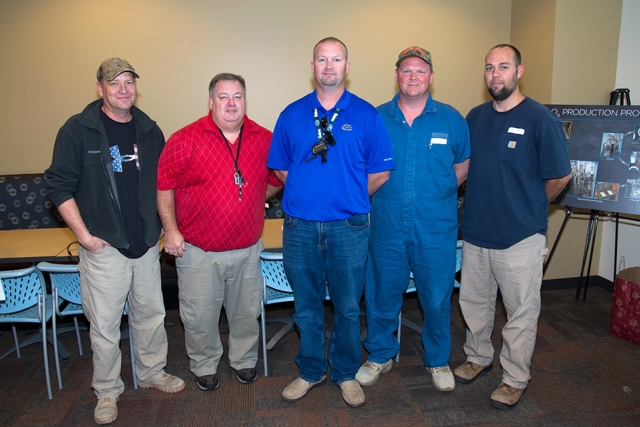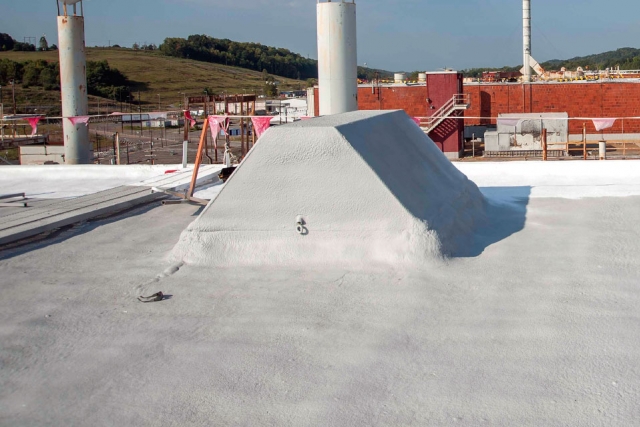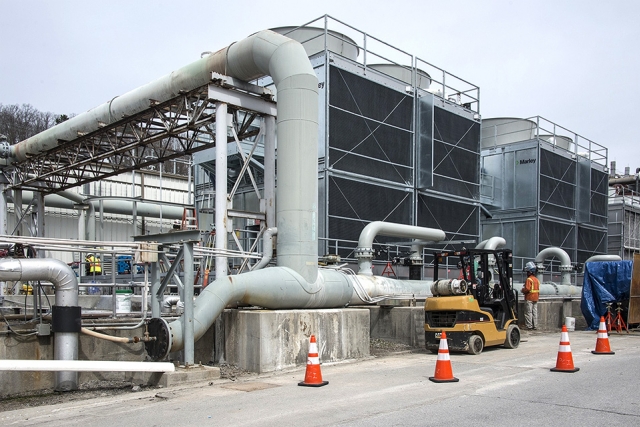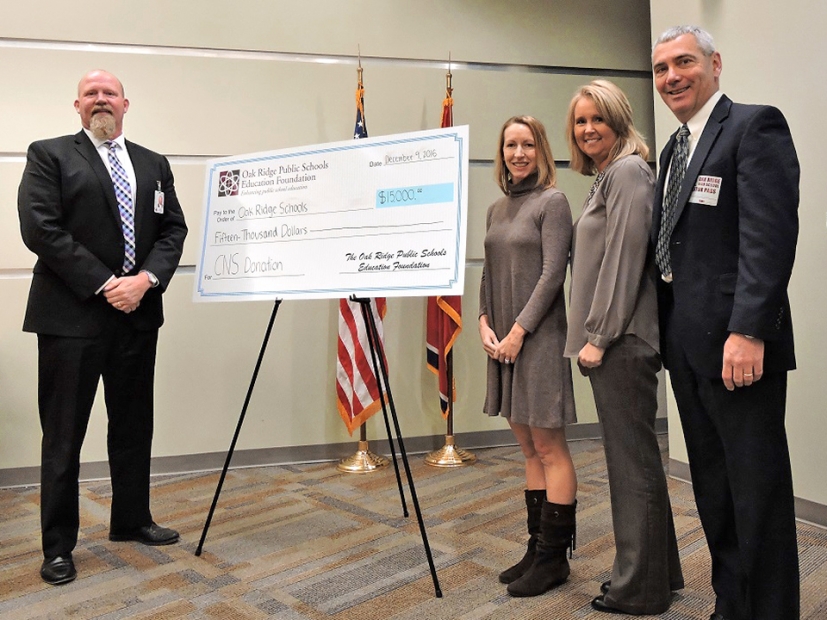Y-12 Blog
 Members of Y-12 Special Operating crew celebrate their successful year, producing material for HFIR. From left: Rodney Raley, Steve Watson, Chad Owings, Andy Trentham, and Derek Chittum.
Members of Y-12 Special Operating crew celebrate their successful year, producing material for HFIR. From left: Rodney Raley, Steve Watson, Chad Owings, Andy Trentham, and Derek Chittum.
Picture the brightest lamp in your house — let’s assume it uses a 100 watt bulb — and think of the amount of heat it gives off if you hold your hand directly over it.
Now, picture 850,000 lightbulbs and the heat they would produce. Then cram all that energy — all 85 million watts — into a space as small as a household trashcan. That’s the concentration of power produced inside the High Flux Isotope Reactor at Oak Ridge National Laboratory.
And it wouldn’t be possible without Y-12’s uranium processing expertise.
Historically, Y-12 produces 80 kilograms of oxide feed material each year, which is sent to a facility in Lynchburg, Virginia, for fuel plate fabrication, although annual volume varies.
“This year, they asked us how much we could make, and we calculated we could produce 125 kilograms for them,” said Don Bible, Y-12’s HFIR project manager.
Y-12’s ability to meet HFIR’s needs is imperative.
Meeting those specifications is crucial to HFIR safely and reliably achieving its highly controlled nuclear reaction, which is used primarily to produce neutrons for research and discovery. During each HFIR cycle, beams of neutrons travel through tubes to adjoining research areas. There, they bombard any number of materials — from metals and plastics to liquid crystals and proteins — allowing researchers to see and understand them on an atomic level.
“Neutrons are a really good way to look inside materials,” David Renfro, HFIR nuclear engineer, noted.
“This can help us understand different materials and learn how they function, so we can use that knowledge to solve problems — from improving medications to building better batteries.”
Y-12’s Special Processing crew recently toured the HFIR facility to see their product in action. Before that trip, few understood HFIR’s unique capabilities or national importance.
“I knew our products went there, but I didn’t have a clue what it was for,” Chemical Operator Derek Chittum said. He added, “And I’ve been running this process for six years.”
Production Specialist Steve Watson organized the tour to provide a little extra motivation to a crew that worked many long days and weekends to deliver their mission.
“I wanted them to see first-hand what the long hours were for and what it truly meant,” Watson said.
On the tour, the operators saw the reactor pool, control room, and associated research facilities. They learned how the fuel plates are fabricated and how the lab welcomes users from around the globe to conduct studies at HFIR free of charge.
“It was a good tour. It’s very interesting to see the final product,” Andy Trentham, chemical operator, said. “Our product is going over there to help people research important things.”
Having the end in mind helped Y-12’s operators understand their own role in the process.
“It helps you appreciate what you do,” Chittum said. “The product we keep putting out keeps that reactor running. They’ve told us they couldn’t do it without us.”
That new appreciation for the work — and their vital role in it — inspired the crew to work overtime to meet the year’s deliverables.
“When we were asked if we thought we could make the commitment, the guys in the crew took it as a challenge,” Watson said of the 125-kilogram goal. “They didn’t hesitate. Their answer was, ‘We will make it.’”
For more information on the High Flux Isotope Reactor and its four primary research capabilities, visit their website.
Since 2006, Y-12 has been working to address aging facilities that are being used beyond their design life. The Department of Energy (DOE) and the National Nuclear Security Administration (NNSA) recognized Consolidated Nuclear Security’s (CNS’s) efforts as a best practice for its holistic approach to infrastructure.
Jeff Moore of Production Support explained how the Plant Health Review Committee, a key component of the Aging Asset Management Program, identifies asset risks to safe and reliable plant operations and prioritizes associated risk mitigation strategies. Last year, the group achieved a major step forward by fully integrating with the Enterprise Risk Management (ERM) organization to perform asset risk assessments that ultimately drive investment priorities.
Tommy Dodson of ERM said, “The adoption of the ERM process meant applying an established method, using common criteria, and resulting in relevant and reliable risk measures, of which stakeholders could proactively manage.”
Moore said, “Structure, system, and equipment needs are identified through system health reporting and other condition monitoring activities. When needs cannot be addressed by the Facility Health Review Committees, they are escalated as unmitigated risks to the Plant Health Review Committee for funding prioritization.”
Moore worked closely with ERM’s Emily Braswell. “Emily and Jeff devised the most effective means to integrate ERM into the Plant Health work. Emily has stayed an active partner in the committee meetings, ensuring the consistent and continuous application of ERM principles,” Dodson said.
Another component of the Aging Asset Management Program is Y‑12’s Extended Life Program (ELP). Y-12 created the ELP in response to certain capabilities being removed from the Uranium Processing Facility scope, resulting in several production buildings serving an enduring mission after completion of the Uranium Processing Facility.
“Buildings 9204‑2E and 9215 are required to serve an enduring mission,” Moore said. “The ELP leverages the Aging Asset Management Program to evaluate the material condition of these facilities. The ELP includes the additional scope of reviewing regulatory requirements and developing a safety strategy for sustained operations.”
The Y‑12‑established Plant Health Review Committee looks beyond the enriched uranium capability and reviews all required processes and infrastructure at Y‑12. System engineers perform periodic health assessments of key systems.
Moore said, “The greatest success has been creating a plant‑wide forum where asset needs are prioritized holistically with respect to the Y‑12 site. This ensures priorities are identified in an integrated and risk‑informed manner so that out‑year budget requests accurately reflect what is required to sustain Y‑12’s mission capabilities.”
Dodson said, “ERM promotes the uniform evaluation of risks across CNS, which fosters mutual appreciation and informs decision‑making.”
“Being named a best practice affirms the Y‑12 Aging Asset Management Program is a value‑added endeavor and signifies a milestone in programmatic maturity. It is not viewed as recognition of achieving an end‑state but rather a charge to continue advancing,” Moore said.
As a direct result of these advances at Y‑12, CNS, is currently working to stand‑up a Plant Health Review Committee at Pantex to ensure consistency in the risk prioritization process between the two sites.
 Significant prep work was required to seal and frame penetrations at Building Alpha‑5, but the new commercial foam roofing material will result in a significant reduction in facility flooding and water leakage.
Significant prep work was required to seal and frame penetrations at Building Alpha‑5, but the new commercial foam roofing material will result in a significant reduction in facility flooding and water leakage.
A project to install new foam roofs on a trio of excess facilities at Y-12 was recently completed ahead of schedule and under budget, but project officials didn’t stop there.
Initially tasked with re-roofing 280,500-square-feet of roofs on Buildings Alpha-5, Beta-4, and 9206, the project was expanded to include new foam roofs for Buildings 9720-22 and 9768, further protecting Y-12 facilities by preventing leaks, sealing penetrations, stopping the roofs from deteriorating, and protecting the environment.
“We finished ahead of schedule and under budget, and also got new roofs on more buildings that need protecting,” said David Lind, the project manager on the roof replacement projects.
Construction and roofing crews wrapped up the $21 million project in mid-October, a month ahead of schedule and about $2.5 million under budget, even with the addition of Buildings 9720-22 and 9768 — shuttered support buildings for Beta-4 and 9206, respectively. The additional roofing work brought the total coverage to over 300,000 square feet.
Lind emphasized that the project was truly a team effort. The contract was awarded under the National Nuclear Security Administration’s (NNSA’s) Roof Asset Management Program to Indiana-based Insulated Roofing Contractors, but CNS’s construction management and direct-hire support team helped remove equipment and debris from the roofs and handled all of the extensive hoisting and rigging for the project.
Safway Services erected a 74-foot scaffold stair tower providing better access to the roof and allowing more efficient monitoring of uncleared workers. Consolidated Nuclear Security (CNS) Physical Security also worked closely with the project team to better utilize Q-cleared escorts according to building and construction equipment configurations.
“A lot of planning and hard work from a large cross-section of CNS and NNSA organizations is what created this success story,” Lind said.
The new roofs are made of two-to-four inches of polyurethane foam with an elastomeric coating that creates a complete membrane to prevent leaks. They are designed to keep water out of the facilities, (Buildings 9206 and 9768 are still in production use) and maintain electrical systems connected to other areas of Y-12 remain in the facilities.
The buildings will eventually be transferred to the Office of Environmental Management and torn down, but a significant amount of work goes into removing hazards from the facilities before they’re turned over to the Office of Environmental Management.
“Taking a $21 million project from planning through completion in just nine months shows our customer how much we can achieve, and it’s good to know these buildings are protected,” Lind said.
 Y-12 has taken advantage of the energy-saving funding opportunities provided by Energy Savings Performance Contracts and has implemented diverse energy improvement projects, such as new high-efficiency cooling towers for the chiller plant.
Y-12 has taken advantage of the energy-saving funding opportunities provided by Energy Savings Performance Contracts and has implemented diverse energy improvement projects, such as new high-efficiency cooling towers for the chiller plant.
The Tennessee Chamber of Commerce & Industry recently recognized the Y-12 National Security Complex with one of its Environment & Energy Awards. The site won the Comprehensive Energy Excellence Award for taking advantage of the opportunities provided by Energy Savings Performance Contracts (ESPC) and implementing diverse energy improvement projects.
“It is an honor to represent Y 12 and receive awards on behalf of the employees who work to make the recognition possible,” said Y-12’s Environmental Compliance Manager Stacey Loveless. “We are happy to share with others the green news we have at Y 12.”
Y-12 has invested in three ESPC projects, including a steam decentralization project that removed some 21 buildings from the plant’s steam distribution system and eliminated more than 3,000 feet of leaking lines. The lines were replaced with natural gas lines. This project is estimated to save almost 1.8 million kWh of electricity, some 170,000 MBtu of natural gas, 36 million gallons of water and more than $800,000 annually.
The second project involved the installation of high-efficiency cooling towers and chiller system upgrades. This project eliminates systems currently using R-22 refrigerant, and it supports infrastructure renewal and eliminates a significant amount of deferred maintenance. Completion of this project will save approximately 16 million kWh of electricity and $1.7 million annually.
A third project replaced or upgraded 37,800 lighting fixtures throughout the site. Existing fixtures were replaced with a combination of LED, long-life T-8, compact fluorescent lamps and other fixture types. Ballasts containing PCBs were replaced with new solid-state ballasts. This project will save more than 22 million kWh of electricity and almost $2.7 million annually.
“Our operations personnel continually look for changes they can implement to improve efficiency, and Y-12’s programs and employees reach beyond the obvious when looking for ways we can improve the environment,” said Loveless.
 From left, Bruce Borchers, superintendent of Oak Ridge Schools, and Jessica Steed, executive director of the Oak Ridge Public Schools Education Foundation, accept a donation from Kristin Waldschlager, CNS education outreach coordinator, and Gene Sievers, deputy Y-12 site manager, to get the Navy National Defense Cadet Corps program started at Oak Ridge High School.
From left, Bruce Borchers, superintendent of Oak Ridge Schools, and Jessica Steed, executive director of the Oak Ridge Public Schools Education Foundation, accept a donation from Kristin Waldschlager, CNS education outreach coordinator, and Gene Sievers, deputy Y-12 site manager, to get the Navy National Defense Cadet Corps program started at Oak Ridge High School.
Oak Ridge High School has a long and storied history of outstanding teams. From girls’ basketball to football, Oak Ridge High School has fielded winners. Next fall, add one more to the list.
Beginning in 2017, the Navy National Defense Cadet Corps (NNDCC) will be on campus, thanks to the Oak Ridge Public Schools Education Foundation (ORPSEF) and Consolidated Nuclear Security.
Similar to JROTC, the NNDCC educates high school cadets in citizenship, promotes community service, and instills responsibility, character and self-discipline. Unlike JROTC, the NNDCC program does not receive federal funding and relies on schools to fully fund the program. CNS provided a $15,000 grant for start-up to get the program off the ground.
“We are so pleased and thankful for the partnership that we have with CNS,” said Bruce Borchers, superintendent of Oak Ridge Schools. “This new program will lead to more of our students attaining the seventh key in our Seven Keys to College and Career Readiness,” he added.
Deputy Site Manager Gene Sievers and CNS Education Outreach coordinator Kristin Waldschlager presented the contribution to Borchers and Jessica Steed, executive director of the ORPSEF.
Said Steed, “CNS’s contribution to offset the startup costs is an outstanding example of key stakeholders working with school officials to benefits student in Oak Ridge Schools.”
In addition to the check presentation, Sievers also addressed members of the Oak Ridge Schools Advisory Board and about high school 50 students who are interested in enrolling in the new program next fall.
Sievers, a former nuclear sub commander, described to the students what the NNDCC offered and how it could lead to a career in the military. He also said, even if the students involved in the program opted not to go into the military, the lessons learned would be valuable in any career path.
“Leadership,” he said, “is not a vaccination. “It is a process, and the Navy National Defense Cadet Corps, though its training, offers the path to leadership,” he said.
